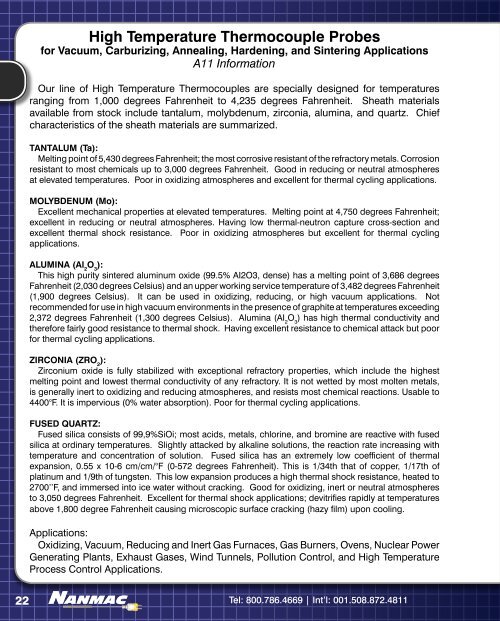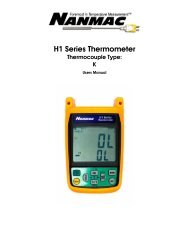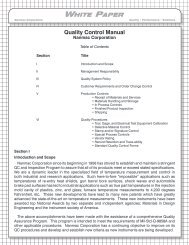Thermocouple - NANMAC Corporation
Thermocouple - NANMAC Corporation
Thermocouple - NANMAC Corporation
You also want an ePaper? Increase the reach of your titles
YUMPU automatically turns print PDFs into web optimized ePapers that Google loves.
High Temperature <strong>Thermocouple</strong> Probes<br />
for Vacuum, Carburizing, Annealing, Hardening, and Sintering Applications<br />
A11 Information<br />
Our line of High Temperature <strong>Thermocouple</strong>s are specially designed for temperatures<br />
ranging from 1,000 degrees Fahrenheit to 4,235 degrees Fahrenheit. Sheath materials<br />
available from stock include tantalum, molybdenum, zirconia, alumina, and quartz. Chief<br />
characteristics of the sheath materials are summarized.<br />
TANTALUM (Ta):<br />
Melting point of 5,430 degrees Fahrenheit; the most corrosive resistant of the refractory metals. Corrosion<br />
resistant to most chemicals up to 3,000 degrees Fahrenheit. Good in reducing or neutral atmospheres<br />
at elevated temperatures. Poor in oxidizing atmospheres and excellent for thermal cycling applications.<br />
MOLYBDENUM (Mo):<br />
Excellent mechanical properties at elevated temperatures. Melting point at 4,750 degrees Fahrenheit;<br />
excellent in reducing or neutral atmospheres. Having low thermal-neutron capture cross-section and<br />
excellent thermal shock resistance. Poor in oxidizing atmospheres but excellent for thermal cycling<br />
applications.<br />
ALUMINA (Al 2<br />
O 3<br />
):<br />
This high purity sintered aluminum oxide (99.5% AI2O3, dense) has a melting point of 3,686 degrees<br />
Fahrenheit (2,030 degrees Celsius) and an upper working service temperature of 3,482 degrees Fahrenheit<br />
(1,900 degrees Celsius). It can be used in oxidizing, reducing, or high vacuum applications. Not<br />
recommended for use in high vacuum environments in the presence of graphite at temperatures exceeding<br />
2,372 degrees Fahrenheit (1,300 degrees Celsius). Alumina (AI 2<br />
O 3<br />
) has high thermal conductivity and<br />
therefore fairly good resistance to thermal shock. Having excellent resistance to chemical attack but poor<br />
for thermal cycling applications.<br />
ZIRCONIA (ZRO 2<br />
):<br />
Zirconium oxide is fully stabilized with exceptional refractory properties, which include the highest<br />
melting point and lowest thermal conductivity of any refractory. It is not wetted by most molten metals,<br />
is generally inert to oxidizing and reducing atmospheres, and resists most chemical reactions. Usable to<br />
4400°F. It is impervious (0% water absorption). Poor for thermal cycling applications.<br />
FUSED QUARTZ:<br />
Fused silica consists of 99,9%SiOi; most acids, metals, chlorine, and bromine are reactive with fused<br />
silica at ordinary temperatures. Slightly attacked by alkaline solutions, the reaction rate increasing with<br />
temperature and concentration of solution. Fused silica has an extremely low coefficient of thermal<br />
expansion, 0.55 x 10-6 cm/cm/°F (0-572 degrees Fahrenheit). This is 1/34th that of copper, 1/17th of<br />
platinum and 1/9th of tungsten. This low expansion produces a high thermal shock resistance, heated to<br />
2700’’F, and immersed into ice water without cracking. Good for oxidizing, inert or neutral atmospheres<br />
to 3,050 degrees Fahrenheit. Excellent for thermal shock applications; devitrifies rapidly at temperatures<br />
above 1,800 degree Fahrenheit causing microscopic surface cracking (hazy film) upon cooling.<br />
Applications:<br />
Oxidizing, Vacuum, Reducing and Inert Gas Furnaces, Gas Burners, Ovens, Nuclear Power<br />
Generating Plants, Exhaust Gases, Wind Tunnels, Pollution Control, and High Temperature<br />
Process Control Applications.<br />
22<br />
Tel: 800.786.4669 | Int’l: 001.508.872.4811




